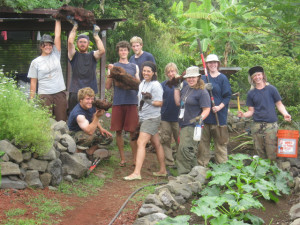By Martha Bouchard, Program Director
What feeds a community?
There are the rote answers: food, water, shelter. But let’s assume your basic needs are being met. What comes next?
For me, it is being part of a community that allows space for people to learn, grow and change.
One of my greatest joys in working for Pacific Quest wilderness therapy program is being a part of a community that is not only open to change, but embraces it. As a leader in the Pacific Quest ohana, I often find myself working within teams to evaluate the effectiveness of each of our systems and resources, creating goals to improve each of those systems, and reflecting on our sustainable growth, as individuals and as an organization.
One of our recent undertakings as part of this process has been the visioning of a 3rd addition of our student curriculum. This new version will be organized to best reflect the building blocks of Sustainable Growth, and will thus mirror a student’s journey of exploring their Sustainable Well-Being, the Sustainable Self, a Sustainable Garden, a Sustainable Community and, ultimately, a Sustainable Transition.
At the heart of each of these curricular themes we find the word “sustainable”. What does that really mean? Is it possible to truly create a sustainable system, a sustainable curriculum, a sustainable learning community, or sustainable growth, in such a fast paced world?
 By definition, in order for something to be sustainable it must be able to be “maintained without depletion”. Students, staff, family members and professionals working with the Pacific Quest community understand that the work we do can feel pretty depleting at times. Each of these roles requires a great deal of time and commitment; physical and emotional output. Frankly there are moments in the process where everyone can feel down right exhausted. So what creates the Sustainable Growth? What is the key to not becoming drained by the process?
By definition, in order for something to be sustainable it must be able to be “maintained without depletion”. Students, staff, family members and professionals working with the Pacific Quest community understand that the work we do can feel pretty depleting at times. Each of these roles requires a great deal of time and commitment; physical and emotional output. Frankly there are moments in the process where everyone can feel down right exhausted. So what creates the Sustainable Growth? What is the key to not becoming drained by the process?
At Pacific Quest, we create a sustainable community by acknowledging that the skills which we use to maintain our natural world without depletion are the same skills that can help us to maintain ourselves without depletion. While there are many layers to what we do at Pacific Quest, ultimately it’s pretty simple.
We all know, logically, that you can’t keep taking, harvesting, benefiting from a natural environment and expect that it will keep giving, growing, providing. In order to expect the we can continue to harvest food from the garden we understand that we must honor the change that goes on within it. As the plants grow they absorb the nutrients of the soil and when those plants are harvested, that soil is downright tired. If we kept planting and harvesting in that same soil, if we refused to acknowledge how much it had just put out and didn’t give it the time and resources to replenish it would not be fruitful. So we allow it to rest and be fallow, we nourish it with humus; we take time to prepare it for the next step. Finally when we plant the new seeds we give them plenty of attention to ensure they have all they need to grow. At each step of this process we observe what works and what doesn’t and learn to incorporate that knowledge into the next attempt.
It’s the same approach we take with people whatever role they play in the PQ ohana: student, staff, family member or other professional. We understand that we can not expect an “ah-ha” moment, after an attempt at a new achievement, after emotional risk and still maintain the energy needed to incorporate this knowledge, learn and give to a community, without going through a process similar to that of the garden. We understand and teach that this process can take a lot of energy from our physical (body), mental (mind) and emotional (spirit) reserves and if we do not incorporate techniques to refill these reserves we will feel depleted.
This is why we rest, eat well, exercise, garden, play; it’s why we teach a process of mindfulness and continual observation. This allows us to acknowledge what needs attention and what needs to change in order to take on our next challenge, “ah-ha” moment, attempt at a new achievement and emotional risk in a new way. We acknowledge that we are in a continual process of learning and changing and that we can take on each challenge as an opportunity for lessons learned, and ultimately for growth.
By embracing these techniques at an organizational level we not only practice what we teach, we also provide evidence for the effectiveness of the model as we continue to strengthen our reputation as a leader in the wilderness therapy industry. This truly makes us a Sustainable Community.